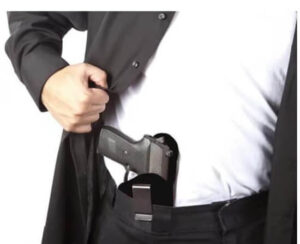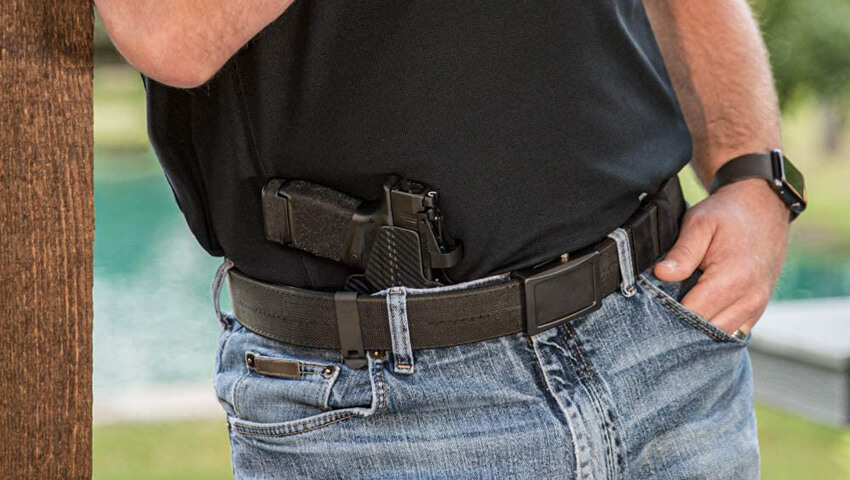Concealed Carry Showdown: Appendix vs. Hip – The Battle Begins!
Concealed carry is an essential aspect of personal defense, allowing individuals to discreetly carry firearms for self-protection. Selecting the right carry method is crucial, as it can affect accessibility, concealment, comfort, and overall effectiveness. In this article, we’ll delve into the two popular carry methods: appendix carry vs hip carry. By understanding their advantages, disadvantages, and key factors to consider, you’ll be empowered to make an informed decision that suits your unique needs.
Understanding Appendix Carry
 Appendix carry refers to positioning the firearm in the front of the body, typically around the abdomen area. This method offers several advantages that make it a popular choice for concealed carriers. Firstly, it provides excellent accessibility and allows for a quick draw, as the firearm is positioned within easy reach of the dominant hand. Additionally, appendix carry offers superior concealment since the firearm is positioned in the natural contour of the body, minimizing the chances of printing or visibility.
Appendix carry refers to positioning the firearm in the front of the body, typically around the abdomen area. This method offers several advantages that make it a popular choice for concealed carriers. Firstly, it provides excellent accessibility and allows for a quick draw, as the firearm is positioned within easy reach of the dominant hand. Additionally, appendix carry offers superior concealment since the firearm is positioned in the natural contour of the body, minimizing the chances of printing or visibility.
Furthermore, appendix carry can provide comfort and mobility for many individuals. With the firearm placed near the centerline of the body, it reduces interference with movements such as sitting, bending, or twisting. However, it’s important to note that appendix carry may not suit everyone. Safety concerns, particularly related to muzzle direction, must be carefully addressed through proper training and adherence to strict safety protocols. Additionally, larger firearms may be more challenging to conceal comfortably with this method, and individual comfort and body type also play significant roles in the decision-making process.
Advantages of Appendix Carry
- Enhanced concealment: The appendix carry method allows for efficient concealment, as the firearm is positioned in a location where it’s less likely to print or be noticed by others.
- Quick and easy access: With the firearm positioned in the front, the draw time can be faster compared to other carry methods, enabling a quick response in potential self-defense scenarios.
- Better retention and control: The position of the firearm allows for easier retention and control, minimizing the risk of an attacker accessing or disarming the weapon.
Disadvantages of Appendix Carry
- Potential discomfort: For some individuals, the proximity of the firearm to the body’s sensitive areas can cause discomfort, especially when sitting or bending.
- Safety concerns: Appendix carry demands strict adherence to safety practices, as the muzzle is pointed towards the body when holstering and unholstering the firearm. Proper training and a reliable holster with trigger guard protection are essential.
- Limited carry options for certain body types: People with larger midsections or unique body shapes may find it challenging to comfortably carry an appendix, as it may dig into the body or cause printing issues.
Exploring Hip Carry
 Hip carry, also known as strong-side carry, involves placing the firearm on or around the hip area. This is the traditional and widely recognized carry method for handguns. One of the primary advantages of hip carry is its familiarity and ease of use. Many individuals find it more comfortable, especially if they have been using this method for an extended period.
Hip carry, also known as strong-side carry, involves placing the firearm on or around the hip area. This is the traditional and widely recognized carry method for handguns. One of the primary advantages of hip carry is its familiarity and ease of use. Many individuals find it more comfortable, especially if they have been using this method for an extended period.
Hip carry offers versatile concealment options, allowing for a wide range of firearm sizes and shapes to be comfortably hidden under clothing. However, it’s important to note that hip carry can have a slower draw time compared to appendix carry. The need to reach across the body and clear any clothing or obstructions before accessing the firearm can slightly hinder response time in critical situations.
Additionally, printing (the outline of the firearm being visible through clothing) can be more pronounced with hip carry, depending on the type of firearm, holster, and clothing choices. Moreover, mobility can be somewhat restricted in situations where the hips are engaged, such as sitting in a car or using a chair with armrests.
Advantages of Hip Carry
- Comfort and familiar positioning: Many gun owners are accustomed to the hip carry method due to its traditional positioning. It allows for a more natural draw motion and can be comfortable for extended periods.
- Wide variety of holsters available: Hip carry offers a vast selection of holsters, including inside-the-waistband (IWB), outside-the-waistband (OWB), and paddle holsters, catering to individual preferences and body types.
- Better weight distribution: By distributing the weight of the firearm across the hip, hip carry can reduce the strain on the body, making it more comfortable for long-term wear.
Disadvantages of Hip Carry
- Reduced concealment: Compared to appendix carry, hip carry may be more challenging to conceal effectively, as the firearm is positioned on the side, potentially causing printing or requiring specific clothing choices for optimal concealment.
- Slower draw time: The draw time from a hip concealed carry position tends to be slower compared to appendix carry, requiring additional time to access the firearm in a self-defense situation.
- Increased risk of retention issues: Due to the position of the firearm on the side, there is a higher chance of retention issues during physical altercations or attempts to disarm.
Comparison of Appendix Carry vs Hip Carry
Both appendix carry and hip carry offer unique advantages and disadvantages, and the choice ultimately depends on personal preferences and circumstances. It’s essential to weigh the pros and cons carefully while considering individual factors such as body type, lifestyle, training level, and legal considerations.
Here’s a comparison table highlighting the key features and differences between appendix carry and hip carry:
| Features | Appendix Carry | Hip Carry |
|---|---|---|
| Positioning | Front of the body | The dominant side of the body |
| Draw Time | Quick and accessible | Longer draw time |
| Concealment | Excellent concealment | Concealment challenges |
| Printing | Minimal printing | Potential printing issues |
| Comfort | May be uncomfortable, restricted movement | Generally more comfortable, better weight distribution |
| Firearm Options | Limited to smaller firearms | Accommodates larger firearms |
| Training | Requires proper training and trigger discipline | Training is still important but may have more flexibility |
| Body Type | Suitable for slimmer builds | Suitable for various body types |
| Lifestyle Activities | May limit movement in certain activities | Better for physically demanding activities |
| Legal Considerations | Comply with applicable laws | Comply with applicable laws |
For those seeking a compromise between the two methods, hybrid carry options are worth exploring. These methods combine elements of both appendix and hip carry, allowing individuals to find a balance that suits their specific needs.
Factors to Consider When Choosing a Carry Method
When deciding between appendix carry and hip carry, several factors need to be taken into account to make an informed decision that suits your needs:
- Body type and personal comfort: Consider your body shape, size, and any physical limitations that may affect the comfort and practicality of each carry method.
- Clothing and wardrobe considerations: Evaluate your typical clothing choices and determine whether they are compatible with the chosen carry method. Tight-fitting or lightweight clothing may require additional attention to concealment.
- Accessibility and draw time: Assess the importance of quick and efficient access to your firearm. Appendix carry typically offers a faster draw time due to its proximity to the dominant hand.
- Concealment requirements: Understand the level of concealment needed based on your lifestyle, environment, and local regulations. Appendix carry provides superior concealment for most body types, but hip carry can accommodate larger firearms more comfortably.
- Training and practice: Regardless of the chosen carry method, investing time in professional training and regular practice is crucial to ensure safe and effective firearm handling.
Conclusion
When it comes to choosing appendix carry vs hip carry, there is no one-size-fits-all solution. Both methods have their advantages and disadvantages, and the decision should be based on careful consideration of personal preferences, body type, comfort, clothing choices, and overall lifestyle. Remember, the right carry method is the one that allows you to carry confidently, access your firearm efficiently, and maintain effective concealment. By understanding the nuances of appendix carry and hip carry, and by assessing the factors that matter most to you, you’ll be well-equipped to make an informed decision and carry with confidence.

